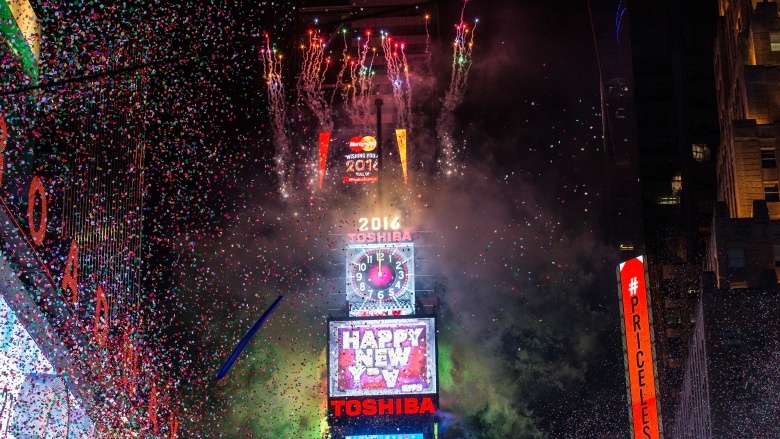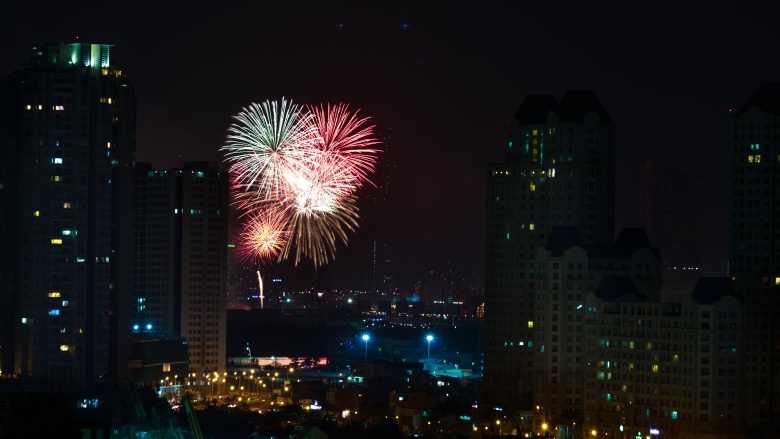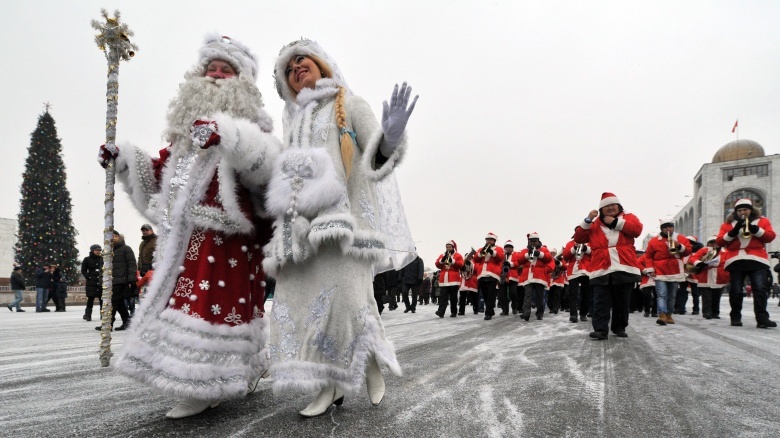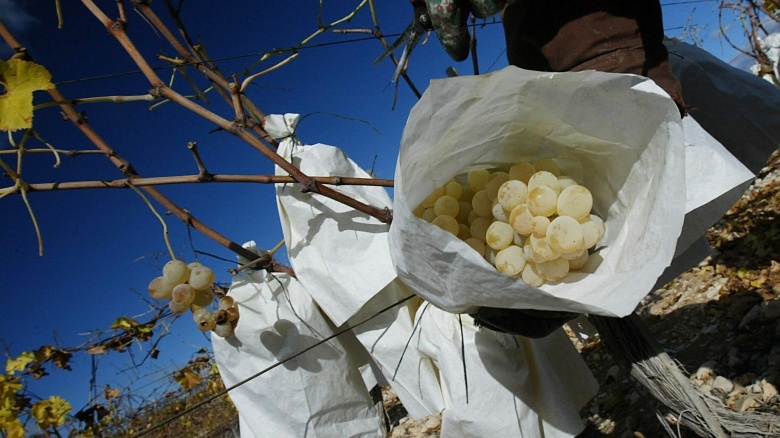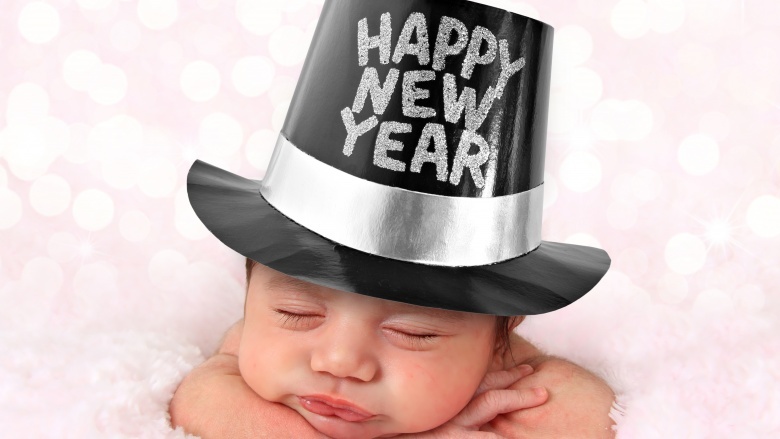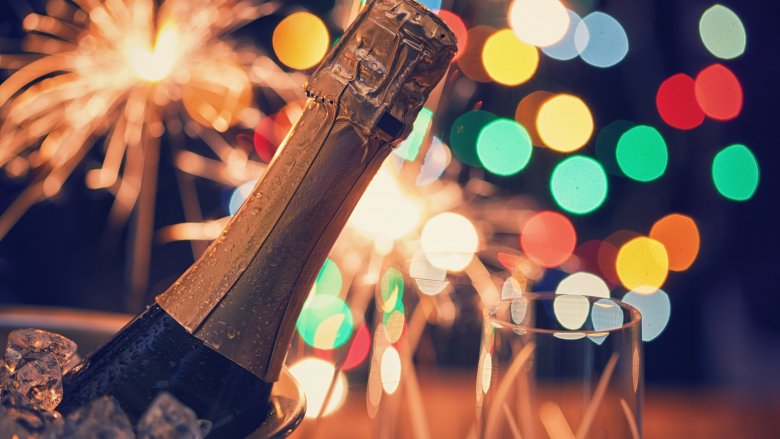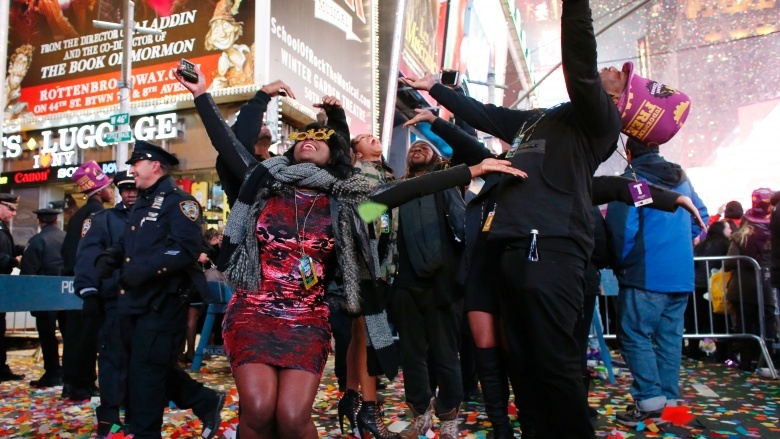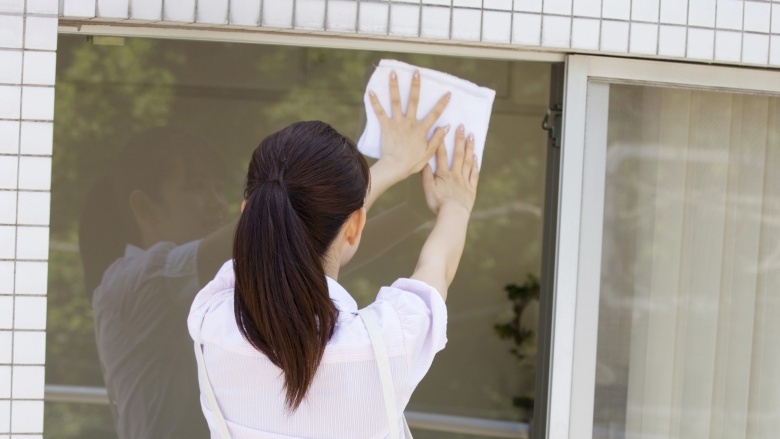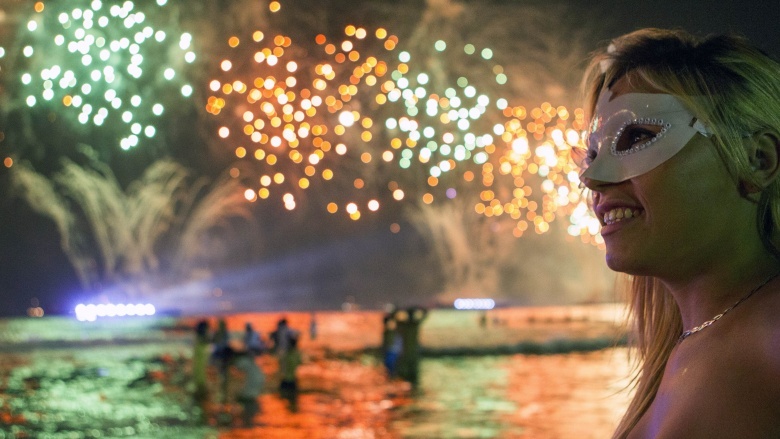Things You Didn't Know About New Year's Eve
The world loses its collective mind on New Year's Eve, indulging in crazy food rituals, drinking themselves into a stupor, dressing like giant babies, and wearing glasses made of numbers. It's absolute insanity, and nobody knows why we do it, or why the baby's wearing a top hat? What's the real story about New Year's Eve, guys?
There's a scientific reason it's terrible
If your New Year's Eve celebration is consistently crappy, science has a solution: stop trying so hard. A 1999 study of 475 New Year's Eve revelers partying like it was, well, 1999, revealed that people who planned and/or attended the biggest bashes were the most bummed about the experience a few weeks later. In contrast, those with the lowest expectations and least amount of energy and moolah invested in the evening came away the most satisfied. Only a depressing 17 percent of auld acquaintances in the study, overall, weren't disappointed about how the night went down, so clearly this dire situation needs to be addressed.
Related studies, as well, have hinted at something happy slackers have been preaching for years: the persistent "pursuit and assessment" of happiness may ultimately be self-defeating. If you want to have a killer New Year's Eve, in other words, it's okay to skip the #YOLO and just go solo, or at the very least, keep your expectations low and savor the experience—whatever it may be. You'll be far less likely to get your hopes up and later make unreasonable, unfavorable comparisons between how your night went and how it was supposed to go. You'll also be considerably less likely to get Jägermeister-tinted puke on your shoes.
A Russian oligarch typically blows $6M on a star-studded Caribbean bash
Perhaps the most extravagant New Year's Eve party in the world takes place on an island named after Christopher Columbus's brother, one that has never cracked a five-figure population count.
Billionaire Russian orphan oil oligarch Roman Abramovich sporadically decides to drop around $6M on a New Year's Eve bash in St. Barthelmy, a Caribbean island owned by France best known as a winter destination for the super-rich. Prince, for example, spent his final New Year's Eve in 2015 on the island, performing at Abramovich's exclusive bash, wearing all black. Dreamworks co-founder David Geffen retired to his yacht before Prince took the stage that night, presumably to sign off on another Madagascar movie via a crystal Bluetooth earpiece, right before playing Jenga with gold doubloons.
Some of Abramovich's famous guests stay on his 536-foot super-yacht "Eclipse," the world's largest private yacht. Locals told the press in 2012, for example, that George Lucas, Ellen Degeneres, Bon Jon Jovi, and the Red Hot Chili Peppers were among his guests. In 2009, Beyoncé, Gwen Stefani, and Prince performed at his estate. In addition to the requisite vodka and champagne on tap, "locally caught langoustines, lobster and tuna" and "Aquitaine caviar-topped blinis canapés" were among the populist fare served in 2012.
In 2015, Justin Bieber performed next door at Leonardo DiCaprio's relatively subdued party. After publicly criticizing Prince for not being "connected with anybody" for asking Abramovich's guests to put their phones away, Bieber walked down to the ocean and "took off his hat [and] sat by himself for a few minutes, apparently deep in thought," according to a not-at-all-sarcastic report from Billboard.
In Russia, Father Frost delivers presents on NYE
Because Christmas was nixed during the Soviet era, many holiday traditions in Russia were shifted to New Year's Eve—"the superholiday of Russian winter"—including the appearance of the bizarro world Santa Claus figure known as Ded Moroz (pronounced "dead morose"), also known as Grandfather or Father Frost. He may resemble Santa Claus, down to the red suit and white beard, but don't get it twisted: Ded Moroz is a trim, scepter-wielding, pagan god of winter who doesn't mess with high-maintenance reindeer or wimpy elves. Like The Doctor, Mr. Moroz gets the job done with a young companion, his granddaughter, Snegurochka, who acts like a trusty wingman, keeping Ded Moroz from drinking too much vodka on his big night. Snegurochka also helps him fight off an evil witch, Baba Yaga, who wants to steal all the gifts he's trying to deliver to the kids on New Year's Eve. (Leave it to the Russians to invent a New Year's Eve antagonist.)
Like Santa, Moroz's presents appear miraculously under a holiday tree, but the Russians dispense with the whole "down the chimney" nonsense. The tipsy Moroz just finds a way, somehow, a few hours before the Kremlin sounds its bells, ushering in the New Year, while all the adults "eat and drink through the night, taking breaks from the festivities to stroll outside in the snow and visit neighbors," according to NPR. Meanwhile, the kids, to keep Moroz happy, have to sing or recite a poem on New Year's Day, like they're getting a weird drunk uncle off their case so they can just go upstairs and play Pokémon already.
In Spain, NYE is all about grapes and red underwear
Remember that scene in Demolition Man, where recently unfrozen supercop Sylvester Stallone learns that people in 2032 used sea shells instead of toilet paper? A baby-faced, prelapsarian Rob Schneider is all like, "He doesn't know how to use the three sea shells!" Sly was baffled, which is kind of how non-Spaniards react to Spanish New Year's Eve traditions (dig that segue). Such traditions involve the following odd props: a dozen specially-grown grapes (las doce uvas de la suerte, or "the 12 lucky grapes"), red underwear, and a gold ring. Huh?
Let's start with the grapes. In June, the Vinalopó grapes pictured above are wrapped in paper bags to slow their maturation, making their skin nice and thin come December, while also conserving their flavor and aroma. It's really important that the skins are thin, because it's a tradition to pop a dozen of these seeded grapes in your mouth on New Year's Eve, like a fruitarian chipmunk. Every few seconds, a bell tolls, indicating it's time to pop the next grape. If you swallow all of them by the thirteenth bell, you'll have good luck in the New Year—if you don't choke to death first.
While hoovering up these grapes, it's really important that you wear a red undergarment—underwear, bra, edible Twizzlers panties, whatever—given to you by someone else. (No one knows why—just run with it.) After you've successfully swallowed the grapes, you're supposed to toast to the New Year with a glass of cava, a local sparkling wine with a gold ring in it, offering you one last opportunity to choke.
All of this insanity—which, choking hazards aside, sounds really fun—is televised, much like the Times Square ball drop. This means millions of Spaniards are chowing down on these grapes at the same time, from the comfort of their living rooms, listening to the bells toll. The commercials that air around the celebrations are the most expensive of the year, like it's the Super Bowl or something. Which raises an interesting question: why haven't Americans developed a face-stuffing tradition on New Year's Eve? C'mon, fellow patriots! Get on it.
Baby New Year was invented to sell magazines
If you can't get enough of all those hilarious grown-ups dressing like babies on New Year's Eve, thank the Saturday Evening Post. The magazine invented the popular image of Baby New Year around the turn of the 20th century to sell magazines. Cover artist Joseph Christian Leyendecker first drew the baby as a simple cherub, but the depiction became allegorical as the years went on, and Baby New Year became symbolic of the issues of the day, portrayed as a soldier, a striking laborer, and an women's suffrage activist, just to name a few of his many day jobs.
In 1937, during the magazine's heyday, Leyendecker drew him wearing a dapper top hat and surrounded by confetti, celebrating a strengthened economy, and the image stuck. So that's why we're all okay with grown folks wearing diapers and Uncle Scrooge hats for one day out of the year. Mystery solved.
Celebratory gunfire is a real problem on NYE
It sounds like a headline from a banana republic: "Dozens Killed By Celebratory Gunfire." But this insanity is happening in major cities across the U.S., including Los Angeles, where at least 39 people have died over the years because many, many adults didn't stop and think about the law of gravity.
In 2014, for example, LAPD received 74 calls about celebratory gunfire on New Year's Eve. In 2013, one poor schmuck got shot in face, but somehow managed to survive. The Los Angeles County Sheriff's Department even started a social media campaign addressing the issue, which sounds like something you'd hear about five years before the dystopia of Idiocracy: "#DontShoot! What Goes Up Must Come Down."
Unsurprisingly, it's also an issue in gun-lovin' states like Texas. In 2014, 43-year-old Javier Suarez Rivera was killed by a falling bullet on New Year's Eve in Houston. His death was ruled a homicide, but unfortunately, the Yosemite Sam-aping imbecile who killed him was never found. The chief of police of Houston told Newsweek in 2015 that his force has to respond to around 200 of these calls every New Year's Eve.
Meanwhile, in New Orleans, the police there are reduced to sending out annual reminders informing the public that, contrary to their action movie fever dreams, there are actual, obvious consequences to firing a weapon into the air. In the words of one exasperated NOLA public information officer, "Falling bullets fall." Newton wept.
New Year's Day is the deadliest day of the year for pedestrians
It may sound like an urban legend, like the old chestnut about spousal abuse increasing during halftime of the Super Bowl, but this one's legit. Thanks to New Year's Eve revelry, New Year's Day is, in fact, the deadliest day of the year for pedestrians in the U.S. Alcohol, of course, is to blame. Over a 15-year stretch, researchers reviewed hundreds of NYE pedestrian deaths. In more than half of the cases, the pedestrians had high blood alcohol levels.
That's right: it's not just about drunk drivers, though they're a huge problem, as well. Drunk walkers getting clipped by sober drivers like they're Walking Dead extras is a sad NYE tradition. Drunk walking accounted for 36 percent of overall pedestrian deaths in 2012, for example, and that's looking at incidents year-round. Add in the concentrated, extra-strength debauchery of NYE and, on average, an insane 24 pedestrians are killed each holiday, turning our great nation into a gigantic game of drunken Frogger, from sea to shining sea.
Cleaning your whole house on NYE is a Japanese tradition called Ousouji
Perhaps the most pragmatic and productive New Year's Eve celebration in the world is the Japanese tradition of Ousouji, which is sort of like the casual American tradition of "spring cleaning." You clean your entire house and/or office on NYE to give yourself a fresh, clean start come January 1. As Akiki Sato puts it in St. Cloud State University's Kaleidoscope magazine, the act is meant to "welcome the New Year and to wish a better life than the former year."
Fortunately, the drudgery of Ousouji is followed by the feast of Osechi—a traditional Japanese dish made with fish, beans, and eggs—and Toshikoshi Soba, which means "New Year's Eve Noodle." The noodles are extra long, symbolizing the desire for an extra-long life.
Japanese NYE celebrations aren't just about deep-cleaning and symbolic noodles: there's also some Must See TV. The "Red and White Song Contest," an annual "Battle of the Sexes"-style singing competition going strong since 1951, consistently pulls in some of the highest ratings of the year, which is impressive, considering it's more than three-and-a-half hours long.
So let's review: a clean house, giant noodles, and almost four hours of reality TV? Forget freezing your face off with Ryan Seacrest, waiting for a tacky chandelier to fall — the Japanese have this New Year's Eve thing figured out.
It's possible to celebrate NYE twice in one day
If you love New Year's Eve so much you want to celebrate it twice in a row, there are a few ways to do it. The islands of American Samoa and Samoa, while just 100 miles apart, are technically separated by 24 hours, thanks to the International Date Line. Samoa is the first inhabited place on the planet to celebrate the New Year, so that's your first stop. Once the party's over, just head to American Samoa, the last place on the planet to celebrate, and do it all over again. Whoo-hoo!
Less remote, but more rushed ways to time travel like this, include hopping between New Zealand and the Cook Islands, which also involves crossing the International Date Line. Staying in North America, there are a few desirable spots close to time zone boundaries where this can be achieved. There are two beach towns in Northwest Florida—Apalachicola and Port St. Joe—just 23 miles apart, but separated by a time zone. If you don't dilly-dally, you could celebrate the New Year on the beach twice in a row, which has to be worth a scouting badge or something, right?
It's a tradition in the South to eat black eyed peas on NYE to bring good luck in the new year
Why is eating black-eyed peas on New Year's Eve considered good luck in the American South? It's a complicated-but-fascinating story, according to Sara Bir over at Serious Eats.
Historians say that Sephardic Jewish colonists introduced the notion in the South as early as 1733, drawing from a list of foods mentioned in the Talmud that were supposed to bring good luck. The colonists, however, confused the word for "fenugreek seed" with the word for "black-eyed pea," which sounded similar. Regardless, the idea of eating the bean—and yes, it's actually a bean—took off, and remains a custom to this day.
But black-eyed peas came over from Africa via slave ships, long before the Jewish colonists arrived, so there must be something else going on. What could it be? Bir notes that Union soldiers after the Civil War would freely pillage Southern crops, but they weren't keen on black-eyed peas, which they considered feed for the animals. This meant a hearty source of protein was left behind for Southerners of all classes during Reconstruction, increasing the bean's reputation as a token of good luck.
Black-eyed peas also, incidentally, cause the least amount of flatulence of all the beans in the bean kingdom, making them an excellent NYE choice, as far as beans go. No one wants to be packed full of farts during that first New Year's kiss.
